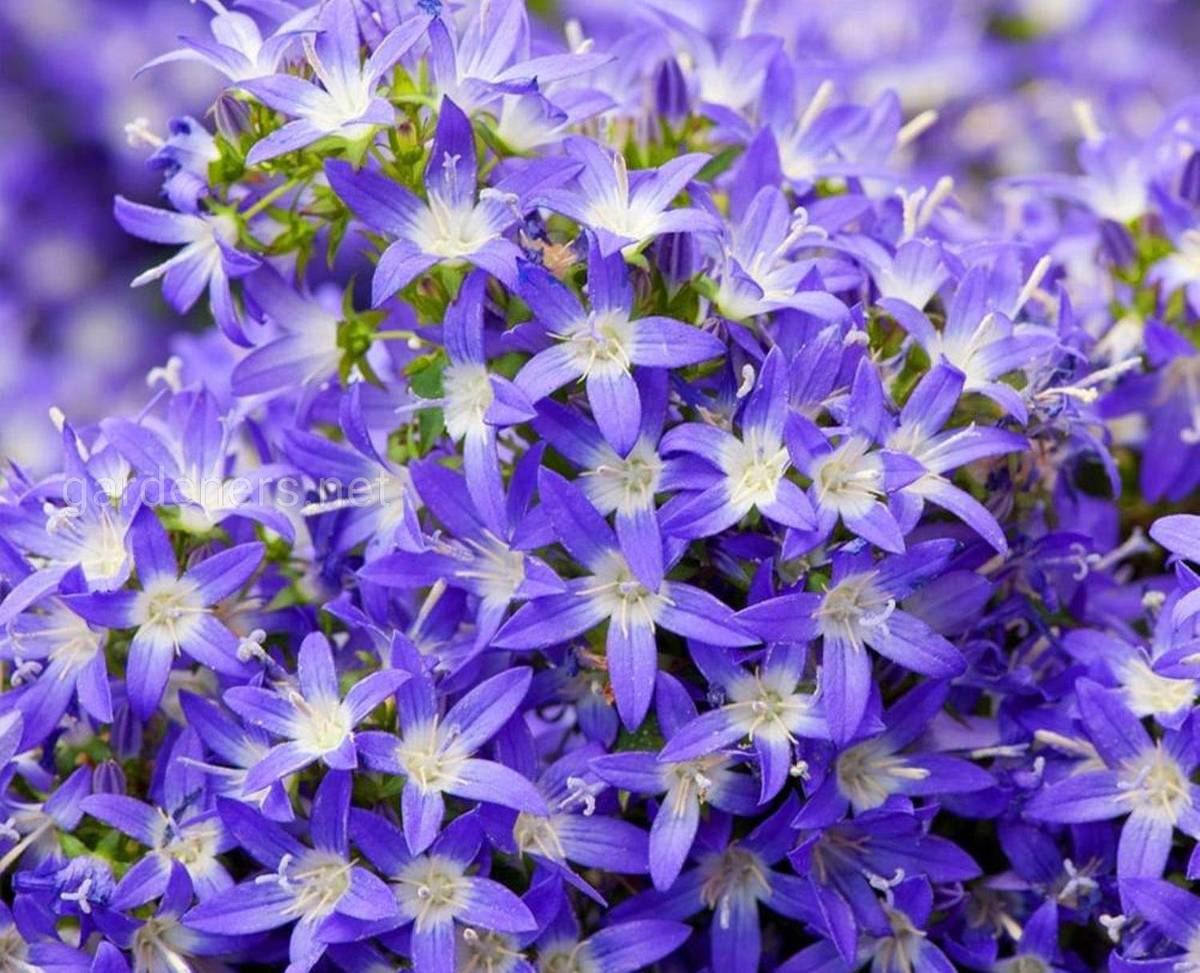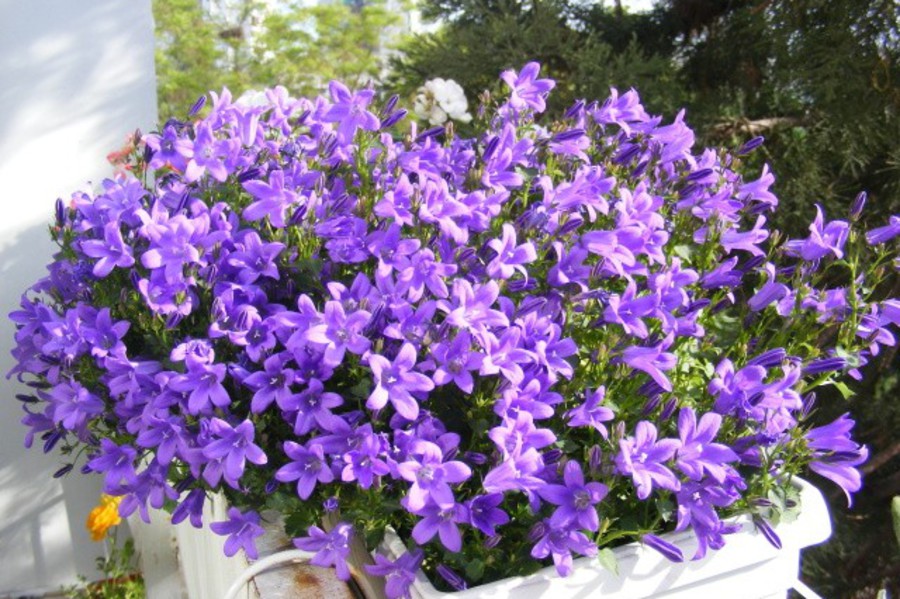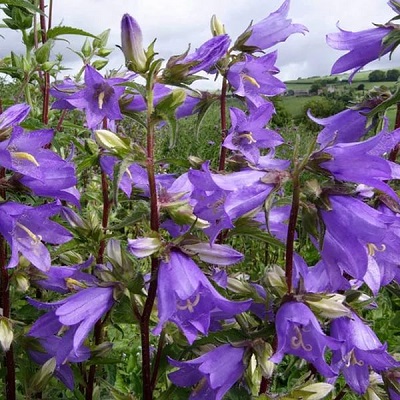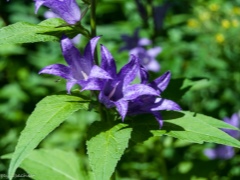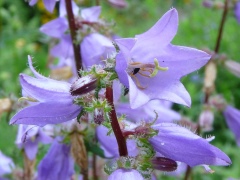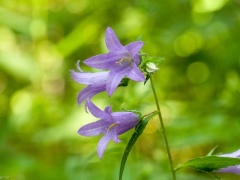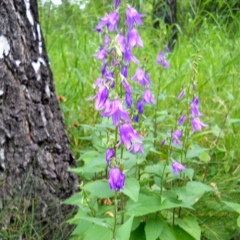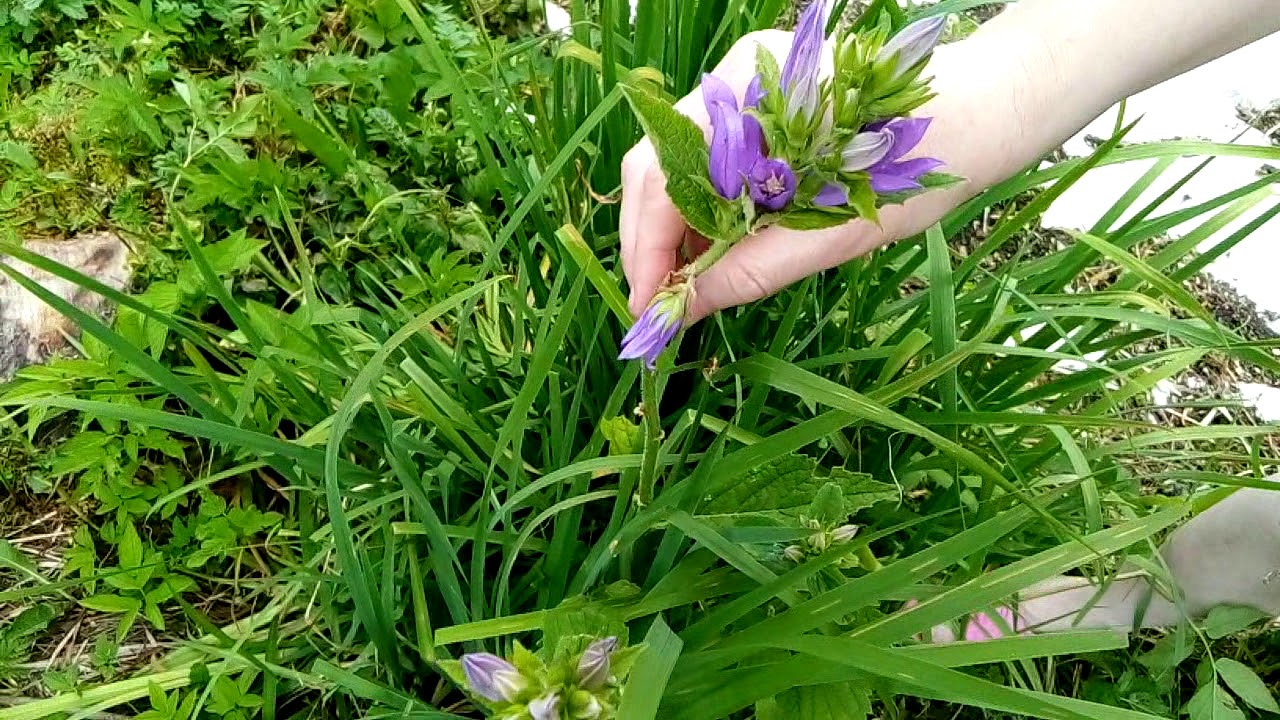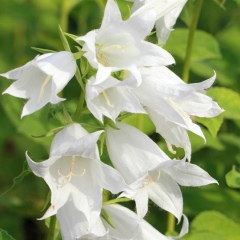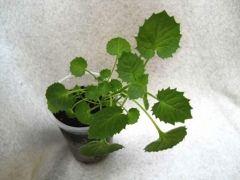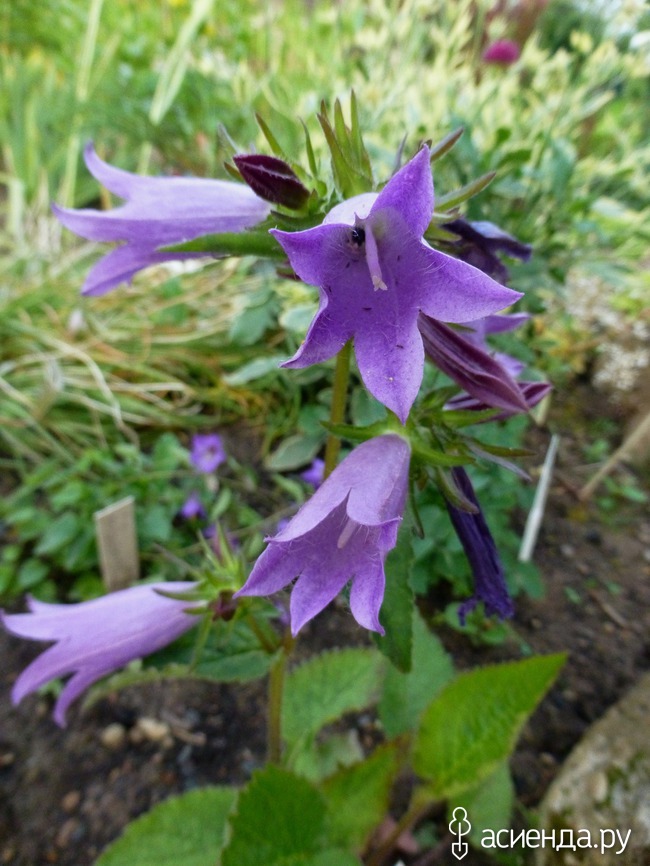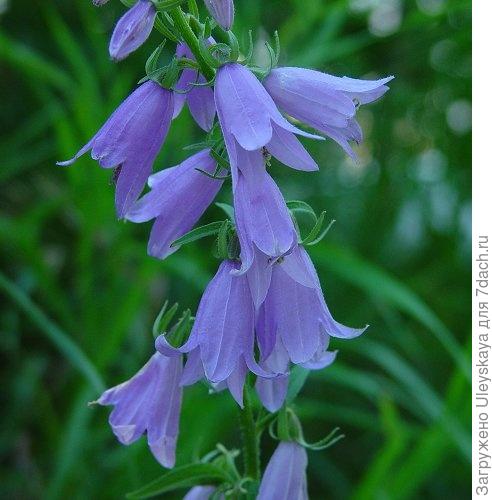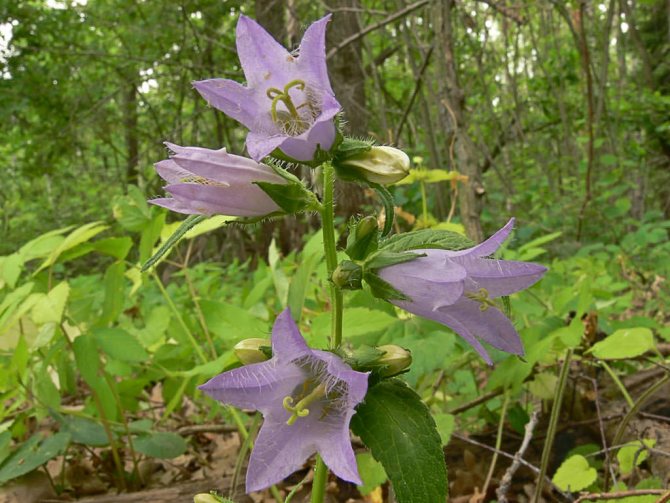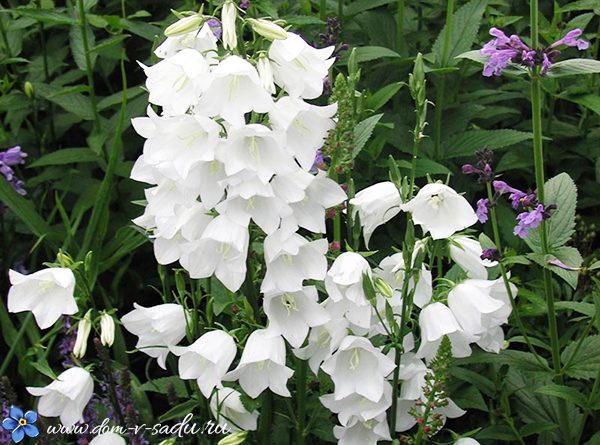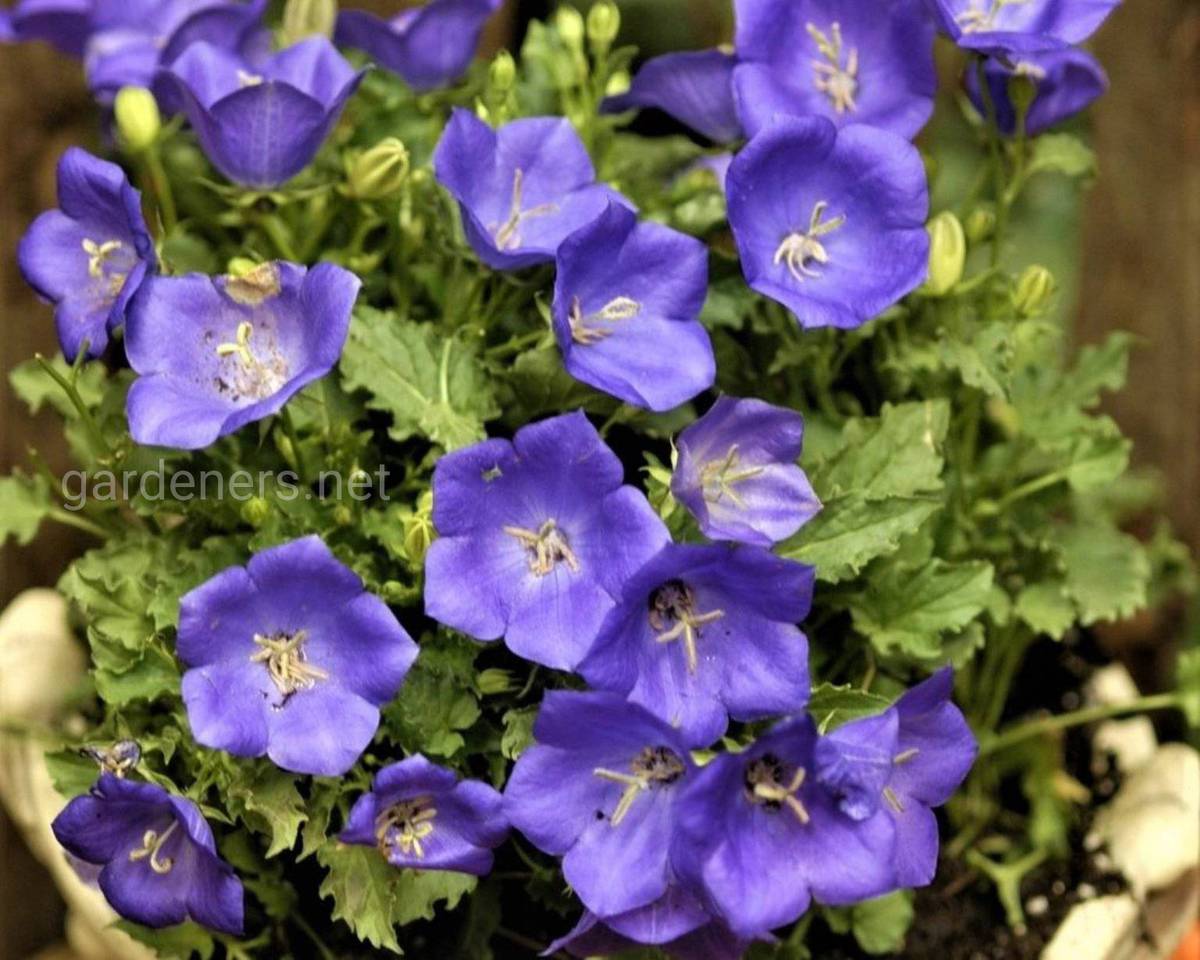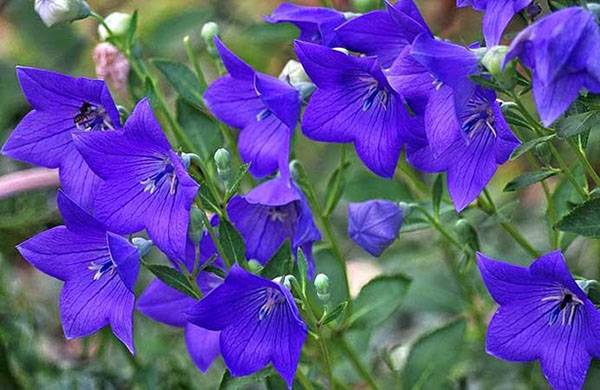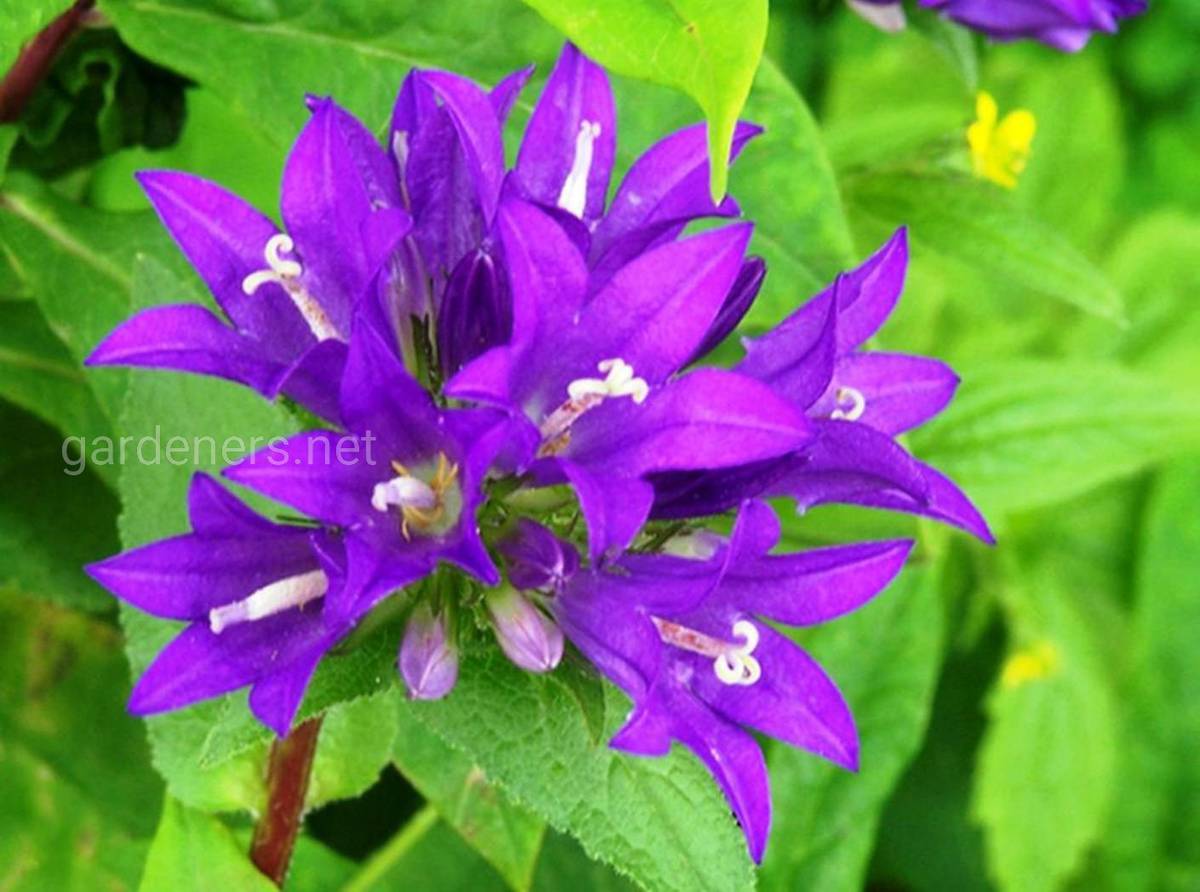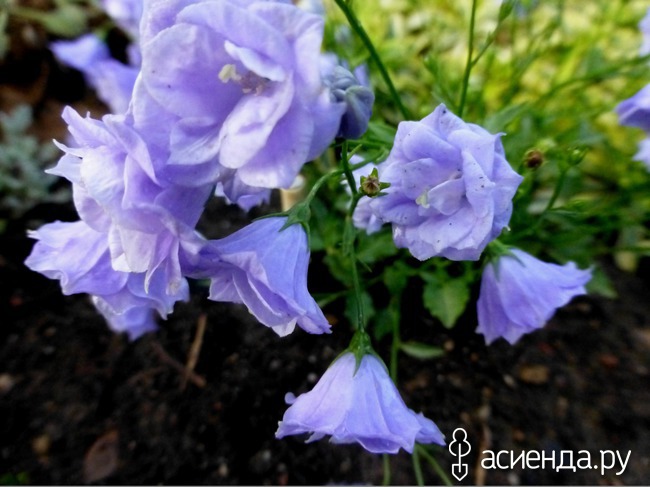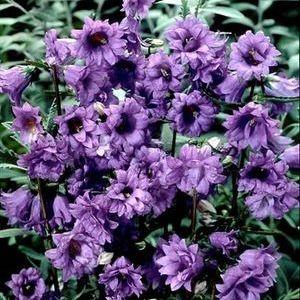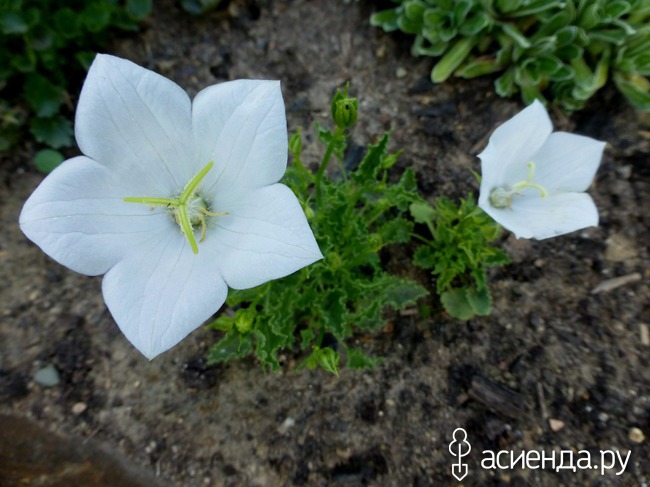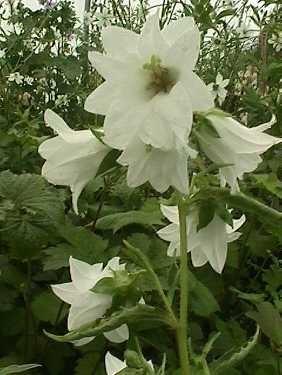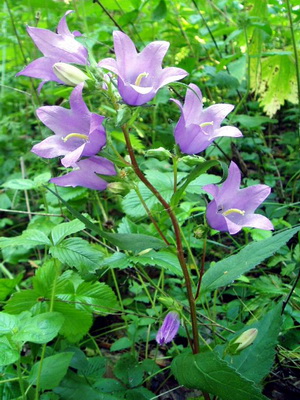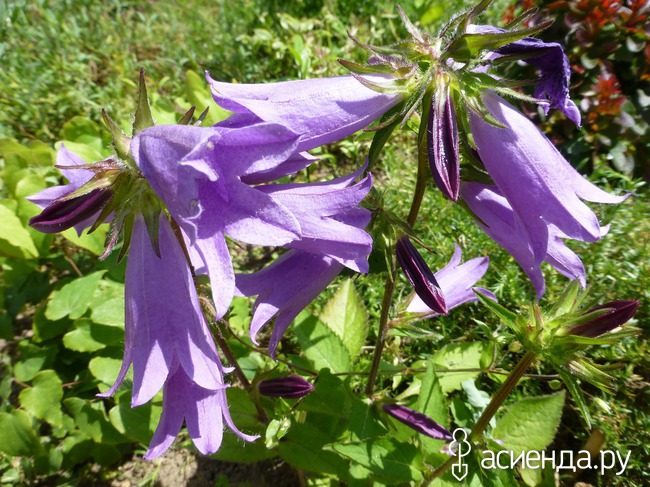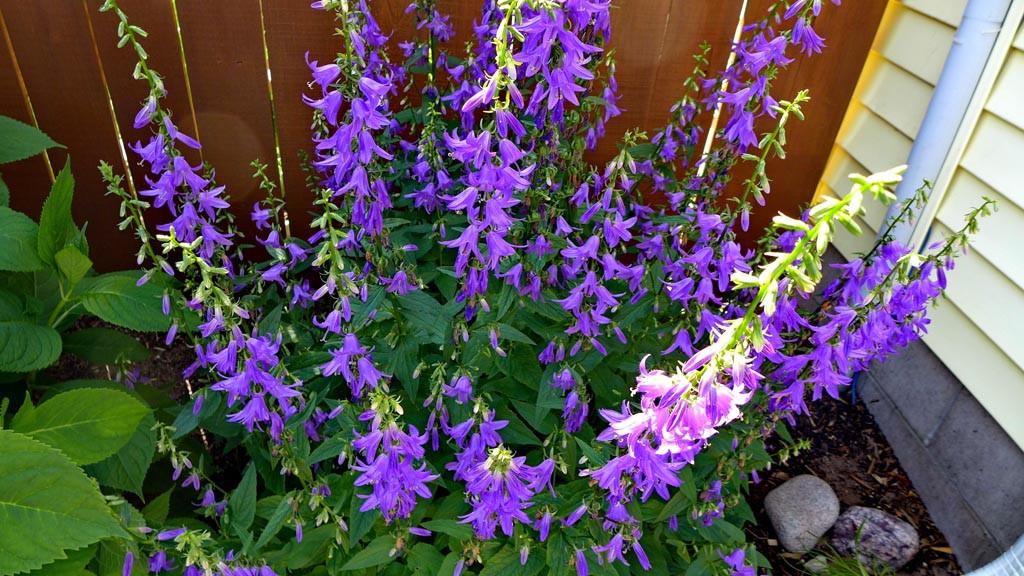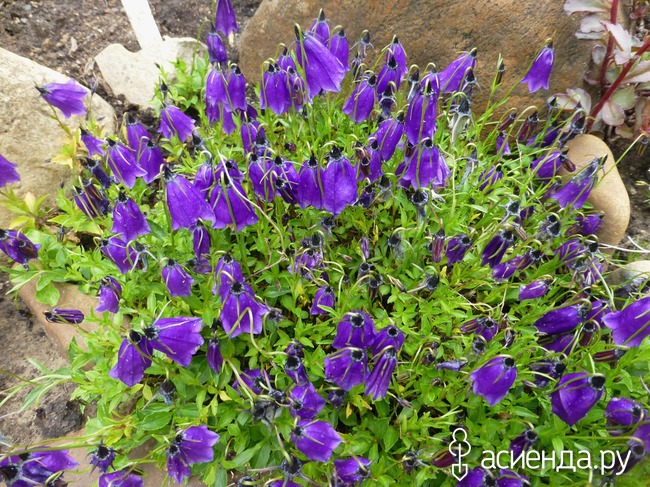Varieties
- Mix of colors - height 80 cm. Double flowers, large, goblet-bell-shaped of various colors, 6-8 cm in diameter. Blossoms in June-September. Biennial.
- Terry mixture of colors - height 80 cm. Terry flowers with a diameter of 6-8 cm, collected in large pyramidal inflorescences. Cut flowers stay fresh for up to 2 weeks.
- A cup and saucer is a popular medium bell variety. Height 80 cm. The flower's cup of original shape resembles a cup standing on a saucer. Mix of colors.
- Carminrose - height 80 cm. Flowers are carmine-pink in color, 6-8 cm in diameter, collected in large inflorescences. Blooms June-September.
- Snezhana - height 80 cm.It blooms with snow-white flowers 6-8 cm in diameter.
- Crimson ringing - height 75 cm. Terry flowers, a mixture of colors.
- Campana white - height 75-85 cm, grown in a greenhouse or open field. The flowers are snow-white.
- Rosea - height 80 cm, with pink flowers.
- Cerulea is a variety with rich purple flowers. Height 80 cm
- Merry gramophone - a mixture of colors, It is distinguished by an erect, coarse-haired stem.
- The dream is a variety with an erect, stiff-haired stem, 80 cm high. The leaves are oblong-oval, stems are ovate-lanceolate. The flowers are large, pink, 4-5 cm in diameter, collected in pyramidal inflorescences, 30-50 cm long. Blooms in June-July.
- Alba is a variety with white pyramidal buds that resemble an ice cream cone.
- Cantenberry Bells is a variety with pyramidal inflorescences. Biennial 80 cm high.Color mix
- Crimson rose is a biennial with pink inflorescences. Flowering period June-July. Height 70-80.
- Rhapsody is a mixture with terry inflorescences of various colors, white, pink, lilac and purple.
The middle bell is not very legible in relation to the ground. Prefers permeable soil, fertile enough and good moisture retention. There will be more inflorescences and larger flowers. On weak soils, to obtain a splendid flowering, in the spring, apply a large dose of compost and a multicomponent dose of fertilizers.
On the best soils, especially those planted in partial shade, the plants will be taller, in case of heavy rain or strong winds, they should be protected from bending.
When buying seeds, you should pay attention to the height of the plants; low varieties can be successfully planted in pots (standing on the ground) as the central element of the composition, or the entire pot can be planted with a bell. But they are completely unsuitable for any type of balcony boxes, too high
If the summer is rainy, terry varieties will suffer more than regular varieties.
Correct care
It is not enough to plant a Carpathian bell correctly, it still requires appropriate care. Let's take a look at how to water, fertilize and prune this plant.
Watering
It is required to provide the pet in question with competent watering. If it rains constantly, there is no need to water the bell. It is necessary to moisten the soil only if the weather is dry. This must be done correctly: at least 10–20 liters of settled water are poured into each square meter. In the remaining time, the rhizomes of the Carpathian bell will easily be able to extract moisture from the ground on their own.
Fertilizer
Perennial bells should be fed twice a year.
The first time you need to apply nitrogen fertilizers. Ammonium nitrate or urea will do. Powder or granular composition is required to be poured onto the ground 15–20 g per square meter. m. This procedure should be carried out at the very end of March. Organic compounds can be a substitute for mineral dressing. After a snowfall, you can shed a flower bed with a mullein or an infusion of chicken droppings.
Pruning
The colors in question do not require cropping.However, gardeners can help flowers in the formation of not too narrow, but a voluminous and well-groomed bush, which will be able to release much more buds. For this purpose, it is only required to pinch points on top of the central and lateral shoots of the first order. Such a procedure will stimulate the growth of branches on the sides. But then flowering will be delayed for a couple of weeks.
Wintering
In order for the bell to survive the frosty season without problems, it will be enough to arrange an uncomplicated shelter made in the form of a shaft from a heap of dried leaves. Peat is also suitable. The pile needs to be prepared when constant frosts come. It should be removed with the onset of early spring.
Images
Showing from 31st to 60th (30 of 153 images found).
Page: first | previous | 2 | next | last
|
Campanula trachelium Lyudmila Saplitskaya |
|
Campanula trachelium Saulius Bagalyunas |
|
Campanula trachelium Yuri Bulany |
|
Campanula trachelium Yuri Bulany |
|
Campanula trachelium Radik Kutushev |
|
Campanula trachelium Radik Kutushev |
|
Campanula trachelium Radik Kutushev |
|
Campanula trachelium Radik Kutushev |
|
Campanula trachelium Radik Kutushev |
|
Campanula trachelium Radik Kutushev |
|
Campanula trachelium Radik Kutushev |
|
Campanula trachelium Radik Kutushev |
|
Campanula trachelium Igor Pavlov |
|
Campanula trachelium Evgeny Zakharov |
|
Campanula trachelium Evgeny Zakharov |
|
Campanula trachelium Evgeny Zakharov |
|
Campanula trachelium Evgeny Zakharov |
|
Campanula trachelium Evgeny Zakharov |
|
Campanula trachelium Dmitry Oreshkin |
|
Campanula trachelium Dmitry Oreshkin |
|
Campanula trachelium Maxim Gulyaev |
|
Campanula trachelium Maxim Gulyaev |
|
Campanula trachelium Maxim Gulyaev |
|
Campanula trachelium Yulia Borisova |
|
Campanula trachelium Yulia Borisova |
|
Campanula trachelium Marina Skotnikova |
|
Campanula trachelium Valery Kudelya |
|
Campanula trachelium Valery Kudelya |
|
Campanula trachelium Valery Kudelya |
|
Campanula trachelium Valery Kudelya |
The main stages of planting calla lilies in open ground in spring
Regardless of how you want to plant calla lilies in the ground in the spring - tubers or sprouted seedlings, you need to do everything right and prepare for planting.
Choosing a landing site
The choice of a place on the street for planting calla lilies in the spring must be approached very responsibly, because these beauties are very whimsical in this regard, and not every site will suit them.
The place must be necessarily light and warm. However, the plant must be protected from direct sunlight, which can burn the leaves and flower. Only slightly shaded and semi-shaded places are suitable - with such delicate lighting, the flowering will be most lush. But when grown in the shade, flowering will be weak or not at all!
Calla loves humid air, so it can be planted near water in your garden. But on condition that there will be no waterlogging at the planting site (for example, this is an artificial pond with a reliable bottom, through which water does not seep).
Soil selection and preparation
Callas are also demanding on the soil! For spring planting, you should choose a fertile, loose, slightly acidic or acidic soil.
In order to successfully grow beautiful and healthy flowers in your garden, you need to prepare the soil in advance before planting the plant. Soil preparation consists of the following stages:
- First of all, it is required to clear the area from stones, debris, weed roots.
- Then you need to dig a trench or hole (the depth is about 30-40 centimeters, but the width is determined by the number of tubers you want to plant). And then you need to fill the hole or trench with soil:
- You can buy a special potting mix for calla lilies at the garden center.
- And you can prepare the earth according to the following recipe: turf soil (2 parts) + leafy earth (1 part) + peat (1 part) + river sand (1 part).
- If you do not have the opportunity to realize the first or second point, then you can put a mixture of humus, peat and garden soil in the pit.
- It is also recommended to apply a mineral complex fertilizer, for example, "Nitroammofoska" (according to the instructions on the package). Then you can not feed the plants in the future (with the exception of potash fertilizers for lush flowering).
Planting scheme for germinated seedlings
It is recommended to plant a calla seedling from a pot into open ground according to the following rules:
- Make the holes slightly larger than the earthen ball in the pot. The distance between the pits is 20 cm (for low-growing varieties), 30-40 cm (for medium-sized ones), 50-60 cm (for tall ones).
- Now you need to carefully remove the germinated seedlings without destroying the earthy coma and transplant them into the holes of the transshipment methods. The plant can be buried 1.5-2 centimeters in order to preserve the surface roots.
- Fill the hole, compact the earth around, water it.
- After the water is completely absorbed, cover the place with peat, a layer of 3-5 cm.
Tuber planting scheme (without preliminary germination)
It is possible to plant the tubers of garden calla lilies in open ground in spring without prior germination. To plant the tubers correctly, you must follow the following scheme:
- Make holes 5-7 centimeters deep, the distance between them is determined depending on the variety (see above), from 20 to 60 centimeters.
- Place the tuber tuber up, and the smooth side (that is, the bottom) to the ground.
- Cover the hole with soil so that the soil covers the upper part of the tuber by 4-5 centimeters (the layer should not be larger, otherwise they will sprout poorly and slowly, and will be weak).
- Tighten just a little (but never too much!).
- Water and mulch after soaking up the water.
Diseases and pests
Preventive spraying in spring and autumn will help to avoid such crop diseases as powdery mildew, rust, damage by various types of fungi. For this, a solution of copper sulfate or "Fundazol" is used. Processing concerns both the crown of the bushes and the ground at the roots of the bell. It is necessary to carry out procedures twice with an interval of a week.
With high humidity, especially with prolonged rainy weather, slugs can attack the culture. To exclude their appearance, regular loosening of the soil is required where they lay their eggs. To combat, gardeners use sprinkling of Epsom salts, dolomite mixture and ash under bushes, and you can also use a homemade spray of vinegar and water (1: 10). Insecticides ("Commander", "Iskra", "Aktara") or folk remedies - a solution of soap or infusion of garlic will help from the aphids that have appeared.
The bell is medium. Cup and saucer. Growing from seeds.
Bells are very beautiful flowers. They themselves are planted on my site. Regular. Almost weedy. But I don't have big bells of various colors. Why not plant them? Let them grow. There is a lot of space. I bought seeds. These are the ones on the right. And as always, I'll start with theory.
Bell middle - С. medium L.
Homeland - Southwest Europe, Asia.
A biennial plant in culture, sometimes grown as a perennial by natural renewal. Differs in an erect, stiff-haired stem 50-100 cm tall. Flowers are goblet-colo-annular, blue, blue, white or pink, simple or double, up to 7 cm long, collected in a pyramidal inflorescence. Blooms from June to September. Fruiting in August-September. Seeds are small, gray-brown. There are 4500 seeds in 1 g. In culture since 1578. Bell Cup and saucer two years old. If you grow it through seedlings, then it blooms in the year of sowing, and if you sow directly into open ground, you will be able to admire the flowering only in the next.
- Location
The plant is light-loving, cold-resistant and moisture-loving. The soil prefers deeply cultivated, rich, sunny location. The bell does not tolerate acidic soils and stagnant water. In damp areas in winter, the plants are weeded out. For 1 sq. m of clay soils are brought under digging 15 kg, loamy - 19 kg of humus or compost.
The flowering of this bell is very rich, the plants are covered entirely with large bells, which makes an absolutely irresistible impression.They are planted singly or in groups against the backdrop of a lawn, in prefabricated flower beds or on beds, used for cutting. In bouquets it also looks very impressive. Cut flowers are stored in water for 10 to 12 days.
Difficulties Besides the fact that bells need good soil for excellent flowering, bells are demanding in terms of growing conditions. They sprout in the dark. Seeds do not sprout in the light. And one more condition. Winter shelter. The bell requires shelter for the winter. Rosettes of leaves that are formed by the fall of the first year need to be covered with dry peat or fallen dry leaves, and a covering material is also well suited for this.
GROWING FROM SEEDS
You can, of course, plant seeds directly into the ground. But then the flowers will appear only next year. Moreover, the bell is especially sensitive to non-compliance with the deadlines for the work. If the rosettes of the root leaves are underdeveloped in the second year, the plants may not bloom, but they do not need to be thrown away - flowering will occur in the third year. In order for the bell to pamper us with flowers in the first year, we need to grow it by seedling method. Sowing bellflower seeds for seedlings in March - early April, for flowering in summer in the same year. Optimum soil temperature for seed germination: + 20 0С. The prepared soil in the seedling box is watered before sowing. The seeds of the bell are lightly sprinkled on top with fine river sand, then the container with the seeds must be put in a plastic bag to create a greenhouse, and be sure to shade the crops. This is the difficulty - the bell does not grow in the light. Bell crops are often sprayed and kept under a black film or covering material all the time. Seedlings appear in about two weeks. It will take another 15 - 20 days for the bell seedlings to get stronger. Then comes the picking phase. Bell seedlings dive in a 10 x 15 cm pattern. The transplanted plants are shaded again until they fully survive, for about a week. Seedling care is normal.
Looking through the literature about bells I saw that bells can be cuttings! It is done like this: Sometimes they practice propagation of the middle bell by cuttings. They are cut in the spring of the second year of cultivation. The rooting scheme is standard: a stalk with one or two internodes with trimmed leaves is planted in moist soil with the addition of sand, the other two internodes are left above the soil surface; kept in a humid warm environment under a film or can with little air flow. LANDING INTO THE GROUND
Planting home seedlings of bells to a permanent place: May - June. If the seeds were germinated in the open field, the seedlings are planted in a permanent place in August. When planting seedlings of bells, you should adhere to the planting scheme, in which the optimal distance between plants is 30 x 40 cm.
MEDIUM BELL (CAMPANULA) sem. Bellflower
Tall species of bell
Broadleaf bellflower Campanula latifolia
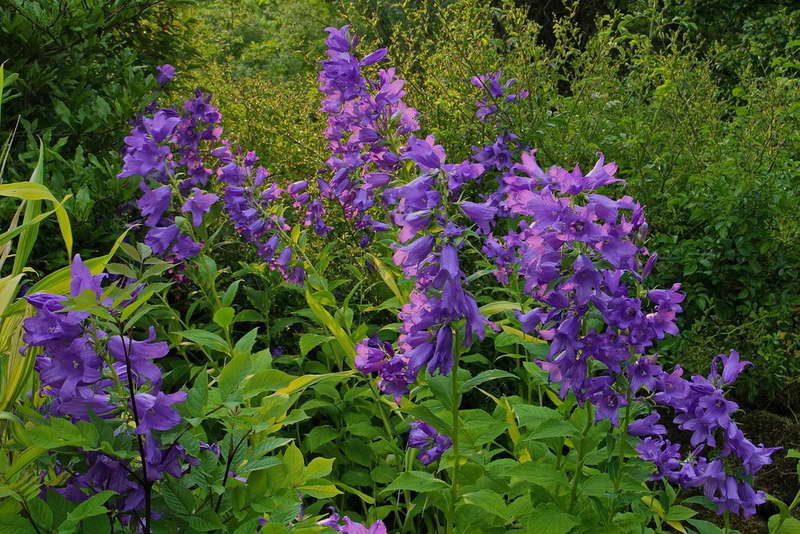
Broadleaf bellflower Campanula latifolia
Distributed in Siberia, Southern and Central Europe, Asia Minor, the Caucasus, in the European parts of Ukraine and Russia. Prefers broad-leaved, dark coniferous, mixed forests and river banks. The stem is straight, glabrous, up to 1 meter in height. The leaves are double-serrate, 12 cm long and 6 cm wide. The flowers are large axillary, gathering in a narrow, sparsely flowered spike-shaped raceme. The flowers are funnel-like, up to 6 cm long, painted in blue, white, blue, the lobes of the flower are slightly bent. Bloom all summer.
Varieties:
- Alba - has white flowers;
- Brantwood - purple flowers; variety with purple flowers;
- Makranta - flowers are large, large-purple in color.
Bell peach-leaved Campanula persicifolia

Bellflower peach-leaved Campanula persicifolia photo
Distributed in Western Siberia, Western Europe, the European part of Russia, Ukraine and the Caucasus. Height from 50 cm to 1 meter. The stem is erect, covered with leaves.The leaves are similar to the foliage of a peach: smooth, serrated at the edges. Flowers are large, shirokokolokolchatye, up to 5 cm in length, are collected in several pieces in a paniculate inflorescence, have a blue or lilac-blue color. There are double and crown forms. Blooms from mid-June to mid-July.
Popular varieties:
- Bernice - blue flowers, double;
- Tetam Beauty - large flowers of a light blue hue;
- Exmaus - dusty blue double flowers;
- Snowdrift - white bells.
- New Giant Highbrides - grows up to 75 cm in height, flowers are large, white and all shades of blue.
Bellflower milky-flowered Campanula lactiflora

Bellflower milky-flowered Campanula lactiflora photo
Originally from Asia Minor and the Caucasus. 50-150 cm high. Taproot, which allows it to grow in heavy loamy soils. Flowers have a milky white hue, up to 4 cm in diameter, are collected in racemose inflorescences. They will open in June and will delight you until the end of summer.
The main varieties are:
- Cerulea is a blue shade of flowers;
- Alba - white flowers;
- Prichard Verayeti - 1.5 m in height, lavender-blue flowers.

Bells crowded companula glomerata photo
Other tall species: Bolognese, Rapunzel, crowded, noble-large-flowered and nettle-leaved.
Carpathian bell in landscape design
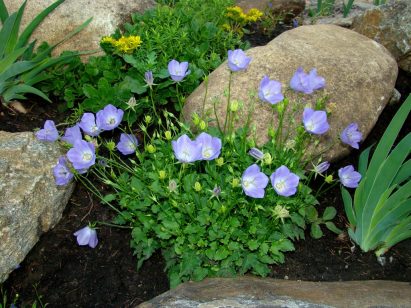
You can use the plant in the landscape design of the garden in the following ways:
- as a decoration for a rocky exposition;
- as a flower border;
- in a group with other plants;
- plant in flowerpots.
Given the fact that the plant comes from a mountainous area, against the background of a small hill, it will look the most harmonious. The simplest rock garden can be made by planting a bell among the stones. Try to dilute the composition with other dwarf ornamental plants, mountain ones will look especially good.
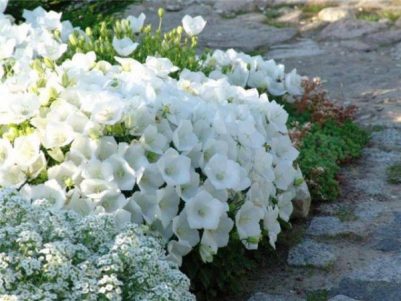
A dense row of bells can be used to mark the borders of the flower bed. It is good to plant such flowers along paths and low garden fences.
In prefabricated flower beds, successful partners are Dalmatian geranium, heliantemum (hybrid sunflower), saxifrage, rejuvenated, daisies, lobelia, obrieta, lobelia, alissum. It is good to combine different varieties of bells side by side, for example, white and blue. Or take an example from the wild: in the meadows of the Carpathians, white and blue beauties coexist with arnica, daffodils and gentian. The Carpathian bell can be combined with tall plants, planting it along the edges in the first row.
Helpful hints and tips
It is worth planting a Carpathian bell, armed with the following recommendations from experienced gardeners:
if you want to provoke a good branching of the plant in different directions, the wilted buds must be removed;
the best place for planting this flower is an alpine slide;
when growing bells in potted conditions at home, it is important to ensure that the temperature in the room where they are located does not drop below +20 degrees;
do not expect a quick flowering of the Carpathian bell if you grow it from seeds; with this method of planting, results can be expected only for 3 years;
you always need to keep the state of flowers under control - although the Carpathian bell is rarely sick, this can still happen; in this case, it is necessary to take action to treat it as soon as possible;
the seed material of the bell is recommended to be taken only in proven places and from well-known manufacturers, so as not to subsequently grow a re-grading of the plant;
you should not fill the Carpathian bell, an excess of liquid will not do it good; excess water can provoke root rot;
if seeds for seedlings were planted at home, starting in February, then, as a rule, mature seedlings should take place in May; it is important to move it to open ground in time, but do not forget about preliminary hardening of seedlings so that it is ready for outdoor conditions;
if you notice slugs on the plants, then the best way to get rid of them would be manual cleaning; chemical compositions in this case may not show much effect.
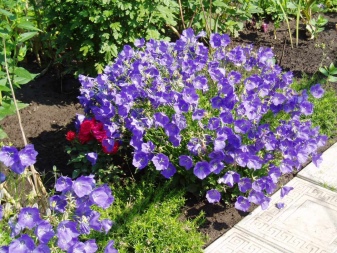
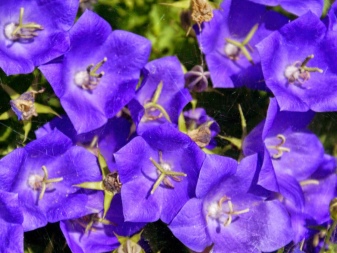
Bellflower nettle
The nettle-leaved bell (lat.Campanula trachelium) is a perennial herb of the genus Bellflower of the family of the same name Bellflower (lat.Campanulaceae). The plant is a natural creature with spectacular leaves decorated with a scalloped edge and relatively large blue-violet bell-shaped flowers.
What's in your name
The Latin name of the genus, which is the first word of all plant species of this genus, "Campanula", has its roots in ancient languages, in which there was a consonant word meaning "noise, roar". Hence the word "bell" was born.
The Latin specific epithet of the name "trachelium" comes from the ancient belief of folk healers that the plant helps to relieve a person from throat diseases, although modern medicine does not confirm this effect.
Therefore, in the Russian version, the species name is based on the shape of the leaves of the plant, reminiscent of the shape of the leaves of Nettle. Thus, the name of the plant acquired the form - "Nettle-leaved bell".
The nettle-leaved bell is a perennial herb. A fibrous thick root that hibernates in the soil is responsible for its perenniality.
In spring, one or more erect non-branching stems from 30 centimeters to one meter in height appear on the surface, the surface of which often has a reddish tint. Leaves differing in shape are alternately located along the entire length of the stem. The lower leaves are ovoid with a heart-shaped base and are distinguished by long petioles. By the middle of the stem, the petioles become shorter, and in the upper part of the stem, the leaves lose their petioles, turning into sessile ones. The upper leaves are ovoid or lanceolate. The leaf blade is covered with stiff hairs and has a jagged decorative edge. In general, all aerial parts of the plant are covered with protective hard hairs.
Flowering occurs from June to August. Spike-shaped short inflorescence, crowning the stem, formed by several drooping flowers. In addition, in the axils of the leaves on short pedicels there are two or three large flowers. Each flower has a protective base of five fused pubescent sepals. The flower corolla has five purple or bluish-lilac (more rarely, white) petals, forming a bell, pubescent inside. Inside the bell is a pistil and five stamens.
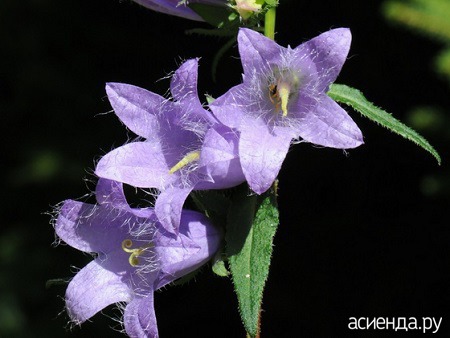
The fruit of the Nettlebellum bellflower is a pubescent drooping boll that ripens in August-September.
In the wild, Nettle bellflower can be found in forest glades, groves and rare deciduous forests, where the soil is rich in humus and relatively moist.
Usage

Thanks to its spectacular dark green leaves with a beautiful jagged edge and large bell-shaped flowers with purple petals, the Nettlebell is popular with flower growers. As a plant of different heights, Nettlebell is suitable for any type of flower garden.
Low-growing varieties fit perfectly into rocky gardens and alpine hills, decorating them all summer with their decorative leaves and bright bells. Tall ones are suitable for mixborders, front gardens, Moorish lawns.
The nettle bellflower loves partial shade or shade, fertile soil rich in humus and medium humidity.
Although mainstream medicine does not recognize the plant's medicinal properties, traditional healers use the nettle-leaved bell as a medicinal plant.
The roots and leaves of the Nettlebellum bellflower are quite edible and were previously used by humans for food.
Varieties
In garden plots, it is customary to grow a large number of crowded bell varieties.The Gnome variety, aka Dwarf, got its name from its low stems, which are only 20 centimeters high. Lilac flowers form lush inflorescences that hide the rest of the shrub. The Alba variety grows up to 25 centimeters in height and rapidly expands in width. The inflorescences are painted in a snow-white shade and appear on the shrub rather quickly, quickly replacing the wilted ones.
The stems of the "Carolina" variety stretch up to almost 60 centimeters. The buds are lilac or blue in color. The Blue variety, as you might guess from the name, produces flowers of a bright blue hue. Straight stems grow up to sixty centimeters mark. Variety "Superba" is characterized by the appearance of blue-purple inflorescences, the diameter of which is 2.5 centimeters.
The stem height is 60 centimeters. Bellefleur Blue is responsible for the appearance of a beautiful, rounded blue inflorescence. Bellefleur Blue stretches up to 25 centimeters in height. Bellefleur White looks the same, but produces white buds. The varieties "Flipper", "Freya" and "Emerald" are also subject to planting.
Reproduction
In addition to growing from seeds and the seedling method, the peach bell can be propagated by division and cuttings.
Growing from seeds
Seed material can be purchased at a specialty store. If there is already a bell on the site, you can collect the seeds yourself. In this case, at the end of summer, the faded box is dried. Then the seeds are extracted from it. This should be done after browning, but before opening the boxes on your own, this will avoid accidental self-seeding.
After sowing, they are covered with foil. You can carry out the procedure in October
It is only important to be in time before the frost. In the second case, the gardener will see the flowering of the culture next year.
Seedling method
The process starts at the end of April. Ground is poured into the prepared containers with the addition of a small amount of humus and sand. And you can also go the other way by buying a ready-made seedling mixture in the store.
The surface of the soil is sprayed with a spray bottle. Then the seed is laid and lightly sprinkled with earth. A thin layer of 2 mm is sufficient. After that, the planting is moistened again. Polyethylene is put on the box, creating a greenhouse environment. At the same time, the seedlings are periodically ventilated.
The boxes should be located in a room with normal room temperature. Seedlings will appear after 2-3 weeks. When the seedlings are visible by 3 mm, the film is removed. Young plants are regularly sprayed up to the first leaves.
When 2 or 3 leaves appear on each seedling, a pick begins
It is important not to miss this moment. Otherwise, the roots of adjacent shoots may intertwine.
In this case, their separation can cause irreparable harm to the flowers.
Young bells are seated in separate cups. If this is not possible, they are placed in a larger container with a distance of at least 10 cm between specimens.
Dividing the bush
This method is applicable only to adult specimens that have reached the age of 3-5 years. The process starts in May. You can carry out the procedure in the fall
The stems are cut, the flower is carefully dug up
Then the root of the plant is divided into 2 or 3 pieces using a sharp knife.
It is important to make sure that the kidneys remain on each part. After this, the places of the cuts are "powdered" with wood ash
Crushed coal can also be used.
The transplant is carried out immediately. Choose suitable sites with good soil. The kidney processes should remain at ground level. After planting, the plants are watered. The soil around each seedling is carefully compacted.
Cuttings
Like the method of dividing, propagation by cuttings allows you to preserve the varietal qualities of the mother bush. By the way, seed reproduction does not give such a guarantee. The procedure is usually carried out in the spring. But you can do this at any time during the summer.
The leaves located on the cuttings are cut to the middle. Then the planting material is placed in a permanent place in the open ground. Sometimes the cutting is first planted in a greenhouse until it takes root.
If the future flower remains on the street, it is covered with a transparent plastic container of sufficient height. You can use a cut bottle. Rooting takes place within three weeks.
Growing at home
Pozharsky's bell is considered the most capricious among all other bell-shaped species. However, he makes some demands on self-care.
Conditions of detention
Since this plant can be grown both in the open field and in the form of a pot culture, the conditions for its maintenance in both cases are very different.
When choosing a place for planting it in the fresh air, it should be borne in mind that although Pozharsky's bell can grow in partial shade, it is still preferable for him to choose a bright place.
Soil and fertilizers
Growing in the wild on rocks and stony soils, these flowers do not impose great demands on the composition of the soil even at home. It suits them almost any, if you add fine gravel to it.
But still they grow best on neutral or slightly alkaline moderately fertile soil, putting forward the only categorical requirement - the absence of stagnant water in the soil.
In the spring, the plant can be fed in the form of humus or compost, and before flowering in May or June, add a solution of mineral fertilizers or wood ash, which should be sprinkled on the soil surface around the plant.
Watering and humidity
The bell does not tolerate spring flooding and nearby groundwater, therefore it does not require abundant watering. In wet weather, you shouldn't water it at all. During all other periods, the soil should be kept in a moderately moist state.
Reproduction
Those wishing to propagate bells are given three options:
- reproduction by seeds;
- dividing the bush;
- grafting.
Seeds
To get seeds for planting, you need to collect the seed pods, which are formed in the place of flowers. These boxes should then be dried and small black seeds should be poured out through the openings in them.
They are sown in the same autumn before the onset of cold weather or in the spring in a warmed-up land. Seeds are scattered over well-dug ground and lightly sprinkled with earth or sand. This is best done in the fall at the end of October, or in the spring - in May.
It is possible to grow seedlings from seeds, which, when three leaves appear on it, are planted in open ground after the danger of spring frosts has passed.
Vegetatively
Most often, Pozharsky's bell is propagated vegetatively in the spring using segments with renewal buds and roots. To do this, the bush is dug out, the aerial shoots are removed, the rhizome is divided into parts with renewal buds and fragments of the root system.
These divisions are planted in a shallow groove so that the renewal buds remain level with the ground. And for propagation by cuttings, exclusively young shoots are taken and rooted with the help of micro-greenhouses.
Relation to temperature
This bell is exceptionally resistant in the face of cold. Even in a snowless winter and without additional insulating shelter, it is able to withstand frost down to -40 degrees. A prerequisite for successful wintering is the cutting of all shoots to ground level.
Possible growing difficulties
This extremely unpretentious and viable plant, hardened in the struggle for survival in mountainous conditions on stony soils and even on rocks, does not cause much trouble for flower growers in their cultivation.
The main thing is that there is no stagnant water under its roots, which this plant does not tolerate in principle. If the groundwater at the site comes close to the surface, then drainage is required.Otherwise, the bells will not take root in such conditions.
Pests, diseases and prevention
The bell is resistant not only to temperature anomalies, but also to diseases, which, as a rule, bypass it.
However, sometimes, especially in prolonged rainy weather, the bell can be visited by slugs and slobbering pennits, which are usually fought with the help of a decoction of capsicum and garlic infusion.
Again, wet weather can provoke the appearance of fungi. It can be sclerotinia, fusarium, botrytis, which can be dealt with by using Fundazole solution.
Sometimes a mouse is not averse to feasting on a bell. The stems eaten by it, of course, will grow back, however, this can have a detrimental effect on the flowering of the plant in the season.
This cute plant leaves almost no one indifferent. The happy combination of the original shape and exquisite colors makes bells very popular plants in country, garden, park and manor landscapes, as well as among potted crops.
Popular varieties
In appearance, bells can be divided into tall and undersized. Most often, tall bells grow in meadows or bright glades, and low bells grow near high rocks or near talus. Almost all of them bloom in the summer.
Undersized
Among the low varieties, it is worth noting the Elizabeth Oliver bell. It differs from others in its abundant pale blue double flowers. The leaves are oval in shape with teeth at the very edge. The height of these bells is only 10-12 centimeters. Most often they are used to create rock gardens or hedges. After all, they bloom for a long time and beautifully. Also, such type of bells as Carpathian can be attributed to undersized plants. The height of almost each of them does not exceed 30 centimeters.
The most popular varieties are the following: snow-white "Alba", blue "Blaumeise", pale blue "Isabel" and many other varieties.
Tall
This includes broadleaf bells. Almost all of them are within 1 meter. In addition, the flowers are very large and beautiful. They need to be grown in partial shade. Speaking of tall plants, one cannot ignore such a variety of bells as "Alba". He is considered the leader among the flowers of his kind. The bush is tall, it can grow up to 1 meter. Green leaves are linear or lanceolate, with small denticles at the very edge. The snow-white flowers are quite large, up to 5 centimeters in circumference. They are collected in beautiful and graceful brushes, with a little drooping.
Blue and blue
The following varieties should be attributed to this category.
"Napoli" is a perennial native to Italy. The height of the bush is no more than 15 centimeters. Leaves in the shape of a heart, with denticles at the edge. Blue-blue flowers in the form of stars have a diameter of up to 3 centimeters. Flowering lasts from May to November.
Lilac and purple
In this category, the following varieties are worth noting.
- Brantwood grows up to 70 centimeters in height. Lilac-purple flowers make up paniculate inflorescences.
- Superba. The height of this lilac-purple plant does not exceed 55 centimeters.
Pink
Many varieties of bells differ in this color. The most common among them are these.
Loddon Anna is a rather spectacular bell with large pink flowers. Very often this plant is planted next to the most delicate roses.






